Troubleshooting Phone Charging Issues Effectively
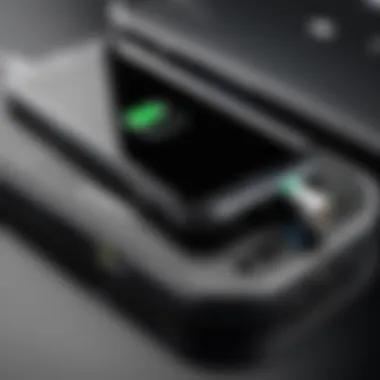
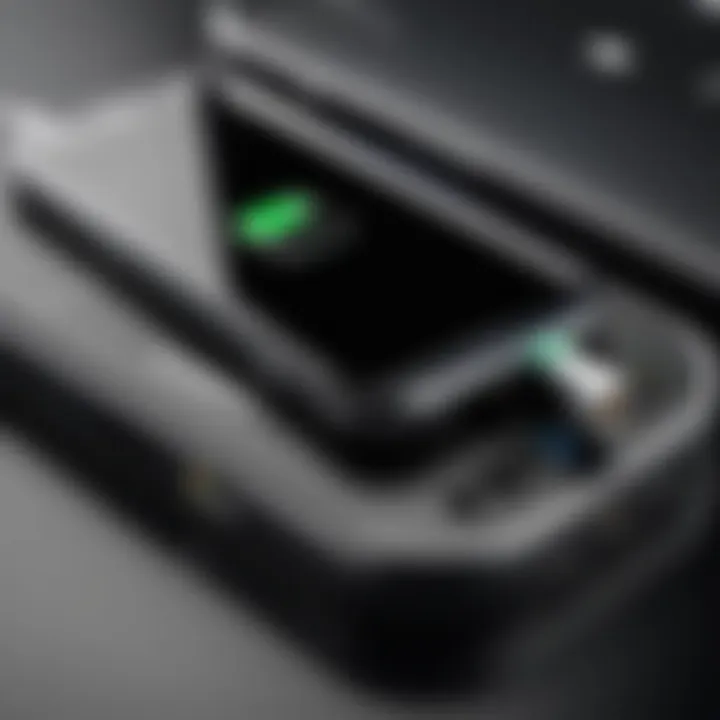
Intro
Smartphones become essential tools in modern life. When they won't charge, it creates frustration. Various reasons can cause this issue, from faulty chargers to software glitches. Understanding these problems is crucial for a smooth user experience.
This article aims to empower users. It discusses common issues that prevent phones from charging properly. This includes both hardware and software aspects. The reader will learn how to identify the problem and apply effective solutions.
We will explore practical troubleshooting steps. Users can maintain optimal device performance through proper care. Let's dive into the key features that are relevant in addressing charging problems.
Understanding Charging Mechanisms
When a phone fails to charge, understanding its charging mechanisms becomes vital. This knowledge allows users to identify the root of issues effectively, ensuring a more efficient troubleshooting process. Charging mechanisms primarily involve the intricate interplay between the battery, charger, and phone's software. Each component needs to function correctly. A good grasp of how these elements work together can prevent frustrations and improve the longevity of the device.
Types of Phone Chargers
Phone chargers come in several types, each with different characteristics and purposes. The most common ones include:
- Wall Chargers: These are the traditional chargers that plug directly into a wall outlet. They often come with various power ratings, typically ranging from 5W to 20W, impacting charging speed.
- Car Chargers: Designed for use in vehicles, these chargers usually plug into the car's power socket. They can be quite convenient for charging on-the-go, albeit often with lower power output.
- Wireless Chargers: Utilizing electromagnetic fields, these chargers enable device charging without cables. They are more about convenience but can be slower than wired options.
- Portable Chargers (Power Banks): These are external batteries that enable charging when away from a power source. Users should check their output capacity to ensure compatibility with their device.
Understanding these types can guide users in selecting the right charger for their needs and mitigate numerous charging problems.
How Battery Technology Works
Battery technology forms the heart of how a phone operates. Modern smartphones utilize lithium-ion batteries due to their efficiency and longevity. These batteries store electricity in a chemical form. When charging, the chemical reaction occurs inside the battery, allowing it to gather energy.
Charging efficiency is influenced by various factors:
- Cycle Count: Each battery has a specific lifecycle, usually around 500 to 1,000 charge cycles before significantly degrading.
- Temperature Sensitivity: Lithium-ion batteries are sensitive to temperature extremes; excessive heat or cold can affect performance.
- Charge Rate: Fast charging can be efficient but may generate more heat, potentially shortening the battery’s lifespan.
Realizing these nuances can help users maximize battery health and signal when issues may arise. A deeper understanding of the battery mechanism is essential not just for troubleshooting but also for extending the device's lifespan.
"A well-charged phone is not just about connectivity; it's about maintaining the essential functionality required for daily tasks."
Acquiring knowledge in these areas strengthens a user's position in resolving charging dilemmas, leading to effective solutions for common issues.
Identifying Common Charging Issues
When a phone won't charge, it can be frustrating. Understanding common charging issues is vital for quickly identifying the problem and finding solutions. This section discusses various factors that could hinder your device from receiving power. Recognizing these issues is essential, not only for troubleshooting but also to prevent future occurrences. Knowing the multiple layers involved in charging—such as the battery, cables, and ports—can lead to a more effective resolution.
Battery-Related Problems
The battery of a phone is a complex component. Over time, it undergoes wear and tear, which can affect its performance. One common battery-related issue is natural degradation. Lithium-ion batteries lose capacity as they age. If the battery is more than two years old and suddenly shows issues, it may be time for a replacement.
Another problem can be virus or software bugs that can affect battery health indirectly. Sometimes, background applications can drain the battery faster than usual, leading you to believe the charging issue is hardware-related. It's useful to monitor battery usage statistics in your phone settings to understand if a particular app is a culprit.
Charger and Cable Failures
Charger and cable failures are quite frequent issues. A faulty charger might fail to deliver the required voltage or current to the battery. Various reasons exist for this failure. Wear and tear, heat damage, or manufacturing defects can cause chargers to malfunction.
Cables, too, can become frayed or broken from constant bending and pulling. A sign of cable failure includes visible wear or no indication of charging when plugged in. Using a different charging setup can help isolate whether the issue is with the charger, the cable, or both.
- Inspect your charger brick for cracks or broken components.
- Check the cable for any signs of damage.
- Testing with another phone can quickly show if the charger or cable is non-functional.
Charging Port Blockages
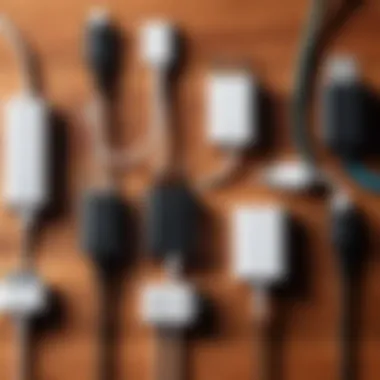
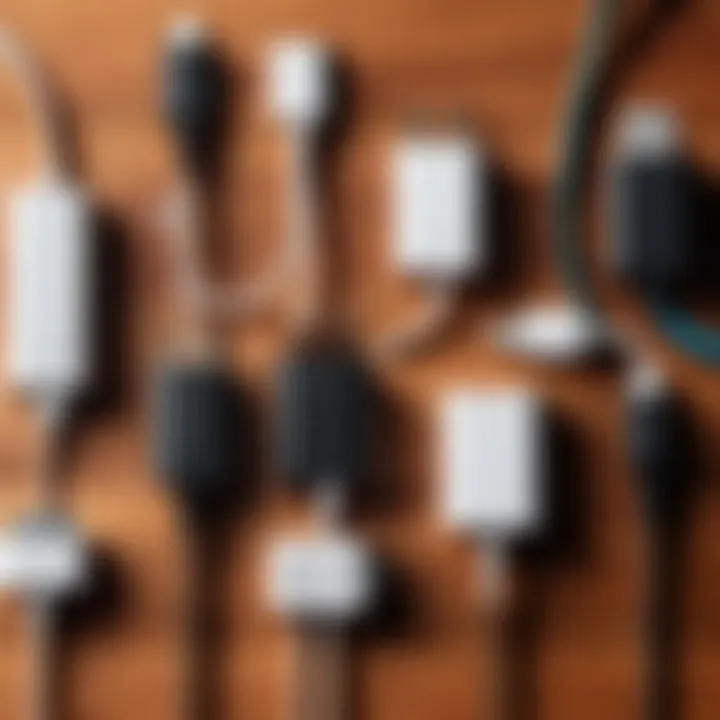
Charging ports can often harbor dust and debris that obstruct proper connections. These blockages can prevent the charging pin from engaging completely, resulting in an ineffective charging process. Inspecting the charging port closely is crucial.
Use a flashlight to check for dirt or lint. If you notice any blockage, gently use a soft brush, compressed air, or a toothpick to clear it. Be careful; aggressive cleaning can damage the port.
Regularly checking and cleaning the charging port can prevent this common issue.
In summary, identifying common charging issues requires attention to detail. Frequent checks on battery health, charger functionality, and port cleanliness can lead to timely resolutions. Taking proactive measures ensures that you reduce the likelihood of facing extensive charging problems in the future. A good understanding of these issues lays the groundwork for effective troubleshooting.
Initial Troubleshooting Steps
When a phone refuses to charge, the experience can be frustrating. Initial troubleshooting steps play a crucial role in identifying and resolving common issues that may prevent charging. These steps are essential as they often provide immediate solutions before delving deeper into potential hardware or software problems. Taking the right initial actions can save time, reduce stress, and possibly avoid costly repairs.
Inspecting the Charging Cable
The charging cable is often the most overlooked element when diagnosing charging issues. First, check for any visible damage, such as frays or cracks. Even a small defect can interrupt the connection. It's also important to ensure that both ends of the cable fit securely. A loose connection can drain power and prevent the phone from charging.
A functioning cable should feel firm when plugged in.
Speaking of fit, if the cable is too worn, it might not make proper contact with the charging port. Testing the cable with another device can also help determine if the issue lies with the cable itself or the phone. If the cable fails to charge another device as well, it is likely time to replace it.
Testing with a Different Charger
Another practical step is to test the phone with a different charger. Chargers may have different voltage outputs, which can affect charging efficiency. Using a charger from a trusted brand can provide better power delivery. By swapping chargers, you can ascertain whether the problem lies with your current charger.
For example, if your phone charges well with a different charger, it indicates an issue with the original one. Make sure to check the compatibility of the charger with your phone model to avoid further complications. If available, try a few different chargers. This process helps eliminate other potential factors causing the charging issues.
Cleaning the Charging Port
Another common but often neglected step is cleaning the charging port of the phone. Over time, debris and dust can accumulate within the charging port, obstructing the connection with the cable. To clean it, use a soft brush or a toothpick with caution. Do not insert anything metallic, as that could damage the port.
After cleaning, inspect the port for any visible obstructions or damage. If you notice anything unusual, this could be a key indicator of deeper issues. Regular maintenance of the charging port should be part of routine care to prevent future charging problems.
By following these initial troubleshooting steps, you provide yourself with a structured approach to identifying and rectifying the common reasons a phone may not charge. Take the time to assess each aspect carefully while keeping in mind that some issues may require professional assistance.
Software-Related Issues
Understanding software-related issues is crucial when diagnosing why your phone may not be charging. Often, users overlook these problems, assuming the issue lies solely with hardware. This section explores various software factors that can hinder charging and offers insights on resolving them. Addressing software issues can enhance device performance, prolong battery life, and ensure a seamless user experience.
Software Bugs and Glitches
Software bugs and glitches are frequent culprits behind charging problems. These flaws can arise from recent updates or particular apps that misbehave. When the operating system or apps do not function correctly, they may prevent the charging mechanism from engaging properly.
To address these issues:
- Restarting the Device: A simple restart can often clear temporary software bugs, restoring functionality.
- Checking for Known Issues: Visit forums like Reddit or manufacturer websites for discussions on any widespread problems related to updates.
- Updating Apps: Ensure your applications are up to date, as developers frequently release patches to fix bugs.
Outdated Operating System
An outdated operating system can hinder your phone’s ability to charge effectively. Manufacturers regularly release updates that not only bring new features but also fix bugs and improve overall performance. Failure to install these updates may lead to software inefficiencies related to charging.
To manage this issue:
- Check for Updates: Navigate to your phone's settings and check for OS updates. Regularly maintaining current software versions can prevent charging issues.
- Install Updates Promptly: Always complete system updates as soon as possible to benefit from fixes and enhancements.
App Conflicts
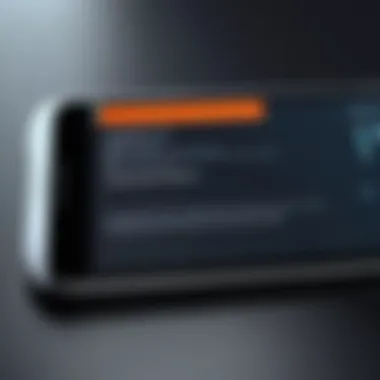

Sometimes, certain applications can conflict with charging functions. These conflicts might stem from apps that run background processes or consume excessive power. For instance, applications known for heavy battery usage can drain the battery while hindering it from charging efficiently.
To mitigate app conflicts:
- Monitor Battery Usage: Check which apps consume the most power in the settings, and consider uninstalling or disabling unnecessary ones.
- Safe Mode: Booting your device in safe mode temporarily disables third-party applications, allowing you to see if an app is interfering with charging.
"Regular software assessments are imperative. Keep your system lean and efficient for optimal performance."
Recognizing software-related issues is a fundamental part of troubleshooting phone charging problems. By addressing bugs, ensuring your operating system is current, and managing app conflicts, users can significantly improve their charging experience. Ensuring that software functions optimally can lead to enhanced battery life and overall device satisfaction.
Advanced Troubleshooting Techniques
Advanced troubleshooting techniques are essential for resolving persistent charging issues that basic checks fail to address. These methods allow users to diagnose deeper problems within their device, ensuring a thorough approach to restore functionality. It's crucial to understand that when a phone exhibits charging issues, the cause may not always be apparent. Therefore, applying these techniques can uncover hidden flaws or malfunctions that standard solutions might overlook.
Performing a Soft Reset
Performing a soft reset is often the most immediate step recommended when facing charging challenges. This process can help clear temporary software glitches that might prevent the device from charging correctly.
To perform a soft reset, follow these simple steps:
- Hold down the power button until the option to power off appears.
- Slide or tap to power off the phone.
- Wait for about 30 seconds before turning it back on by pressing the power button again.
This action refreshes the device's operating system without causing any data loss. Users often report resolution of minor charging issues following this refresh, making it a primary recommendation in troubleshooting guides.
Booting into Safe Mode
Booting into safe mode can be useful in determining if a third-party application is causing charging issues. This environment disables all non-essential apps, allowing the user to isolate whether the problem lies with the integrated system or an external application.
To boot into safe mode, perform the following:
- Power off the device completely.
- Next, turn it back on while holding the specific button combination for your device model (usually the volume down or home button).
- Release the button when the device powers on, and ‘Safe Mode’ should appear on the screen.
In safe mode, if the phone charges normally, it's likely that a downloaded app is interfering with the charging process. Identifying and removing such apps will typically restore normal functionality.
Factory Reset Considerations
A factory reset can be a last resort in troubleshooting charging problems, particularly when all other methods fail. This action restores the phone to its original settings, eliminating any software-related issues that might be the root cause. However, it also results in the loss of all user data, so careful considerations must be made.
Before proceeding with a factory reset:
- Back Up Important Data: Ensure that personal files, photos, and contacts are saved to a cloud service or external storage.
- Document Settings: Keep track of custom settings and app configurations that you may want to restore.
To perform a factory reset, navigate to the device settings, find the reset options, and follow the on-screen instructions. Keep in mind that this step should be chosen only when absolutely necessary, as it can be time-consuming to set up the device again afterward.
Remember to evaluate the necessity of each step carefully; sometimes, minor adjustments can lead to major improvements in device performance.
When to Seek Professional Help
As much as one might wish to solve every problem independently, some charging issues require a more thorough examination by professionals. Understanding when to seek expert assistance can save both time and potential damage. If you try common troubleshooting methods outlined before and find no resolution, it may indicate a deeper issue requiring specialist intervention.
Signs of Hardware Failure
Identifying incidences of hardware failure can often be straightforward. Here are some telling signs:
- Discoloration or Damage to Charging Port: Look closely at the charging port on your device. If you notice any physical damage or discoloration, it could impede your device’s ability to charge.
- Unusual Heating: If your phone becomes excessively hot while charging, stop using it right away. This overheating could signal critical hardware failure, possibly endangering both the battery and the device.
- Inconsistent Charging: If your phone discharges rapidly or charges intermittently, there might be an internal fault. For example, certain components may be failing, leading to these erratic behaviors.
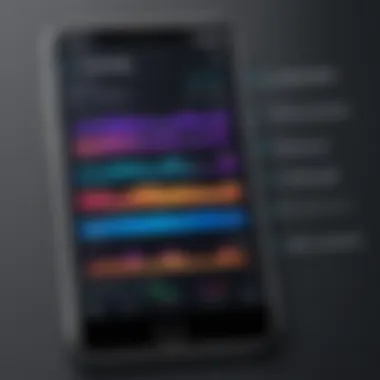

In these cases, direct intervention from a qualified technician can pinpoint the issue and offer solutions tailored to your device’s needs. Professional repair services possess the tools and expertise to conduct a comprehensive diagnostic, which is essential for resolving hardware anomalies.
Connecting with Customer Support
Engaging with customer support can be a decisive step when facing persistent charging problems. Here’s how to navigate this process:
- Gather Information: Before contacting support, compile relevant details. This includes model number, purchase date, and a description of the issue. Having this ready can streamline the support process.
- Official Channels: Reach out through the manufacturer's official customer support channels. For example, companies like Apple or Samsung have dedicated services that guide users through issues, often with access to resources unavailable elsewhere.
- Documented Conversations: Keep records of your communications. This documentation can be useful if you need to reference previous interactions or escalate the issue.
Customer support teams can provide insights based on common device issues, firmware updates, and if applicable, warranty coverage. Their expertise is invaluable, particularly if the problem exceeds general troubleshooting capabilities.
"Many issues can be resolved through customer support that might initially seem insurmountable. They bring a wealth of knowledge about the device in question."
In summary, recognizing when to consult professionals can greatly reduce the risk of worsening the problem. Whether it is through identifying hardware failures or engaging support teams, being proactive can ensure your device receives the attention it needs.
Preventive Measures for Phone Charging Issues
Preventive measures are essential when addressing phone charging issues. They allow users to maintain their devices in optimal condition, significantly reducing the likelihood of experiencing problems in the future. Implementing these practical steps ensures the longevity of both the phone and its accessories. It can save time and avoid unnecessary costs associated with repairs and replacements.
Choosing Quality Accessories
Selecting the right accessories is one of the most crucial steps in preventing charging problems. Using a certified charger and cable specifically designed for your phone model can enhance performance and safety. With many counterfeit products on the market, individuals must be discerning. High-quality components are less likely to suffer damage over time and provide stable charging rates.
- Look for OEM Products: Choosing Original Equipment Manufacturer products ensures compatibility.
- Read Reviews and Ratings: Assessing feedback from other users can inform better purchasing decisions.
Focusing on reputable brands such as Anker or Belkin can also yield better outcomes. These brands typically offer warranties, providing an extra layer of protection should anything go wrong.
Regular Maintenance Tips
Regular maintenance of devices can go a long way in ensuring reliable charging. It's essential to create a routine that includes checking the integrity of charging cables and ports. Small inspections can prevent larger issues down the line.
- Inspect Charging Ports: Dust or lint can accumulate, causing connection issues. Gently clean the port using a dry toothbrush or a can of compressed air.
- Avoid Extreme Conditions: Keep your device away from extreme heat or cold. High temperatures, in particular, can damage battery health over time.
- Keep Cables Organized: Prevent tangling or pinching of cables, which can lead to internal damage. Using cable organizers can help.
Adopting these practices can significantly improve charging reliability and prolong the life of the device and its peripherals.
Software Updates and Security
Software plays a critical role in the overall functionality of any phone, including its charging mechanism. Regularly updating the operating system can address bugs that might affect the charging process. Here are a few considerations:
- Stay Updated: Always install the latest software updates. Manufacturers often release patches to fix bugs that can cause charging difficulties.
- App Management: Limit background apps that consume battery heavily. A cluttered software environment can lead to inefficient charging.
- Security Concerns: Keeping the software updated also protects against malware. Malware can interfere with charging and overall device performance.
By understanding the significance of these software factors, users can improve their phones' operational stability, particularly regarding charging issues.
"Being proactive in device care is far better than being reactive."
Taking preventive measures makes a notable difference in how users can maintain their phones, especially regarding charging. Recognizing the importance of quality accessories, regular maintenance, and software updates will set a solid foundation for enduring and efficient device functionality.
The End
In recent years, the reliance on smartphones has intensified, making charging issues critical concerns for users. This article emphasized the importance of understanding potential problems and offered practical solutions in troubleshooting.
Recapping Key Points
The key aspects covered included:
- Understanding Charging Mechanisms: Insight into different chargers and battery technology helps grasp the core of charging problems.
- Identifying Common Charging Issues: Recognizing signs of battery-related problems, charger failures, and port blockages is essential in troubleshooting.
- Initial Troubleshooting Steps: Basic inspections such as checking cables and cleaning ports can remedy many issues.
- Software-Related Issues: Addressing software bugs or outdated systems is often overlooked but crucial for charging functionality.
- Advanced Troubleshooting Techniques: Techniques like soft resets and safe mode can tackle deeper issues.
- When to Seek Professional Help: Understanding hardware failure and knowing when to contact support is important.
- Preventive Measures for Phone Charging Issues: Utilizing quality accessories and maintaining software updates enhances device longevity.
These elements come together to create a comprehensive framework to handle charging problems effectively.
Encouraging Proactive Care
To ensure your device remains functional, proactive care is vital. Regular inspections of charging equipment, such as cables and adapters, can forestall issues. Keeping software up to date protects against vulnerabilities and performance slowdowns. Additionally, investing in high-quality charging accessories can prevent damage that cheap alternatives might cause. Using methods like avoiding extreme temperatures and managing battery cycles properly also contributes to battery health.



